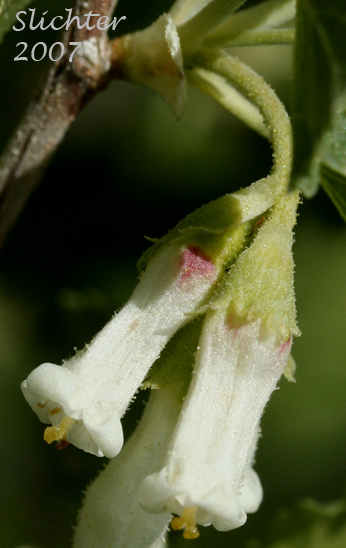Wax Currant, Squaw Currant
Ribes cereum var. cereum
Synonyms: Ribes cereum var. inebrians, Ribes cereum var. pedicellare, Ribes inebrians, Ribes reniforme, Ribes viscidulum

Maturing fruits of wax currant (var. cereum) as seen aong the Pacific Crest Trail on the southeastern slopes of Mt. Ashland, Rogue River-Siskiyou National Forest.........October 15, 2019.
 Photo at right shows a close-up of the flowers of wax currant (var. cereum) as seen at Hog Lake.........April 27, 2006. Note the numerous gland-tipped hairs covering the calyx and corolla.
Photo at right shows a close-up of the flowers of wax currant (var. cereum) as seen at Hog Lake.........April 27, 2006. Note the numerous gland-tipped hairs covering the calyx and corolla.
Characteristics:
Wax currant is a stiff and many-branched shrub with spreading
to rounded growth from 0.5-1.5 meters high. The stems are unarmed and range
from gray to reddish brown in color. The leaves alternate on the stems and are
deciduous. The leave are small, ranging from 1.5-2.5 cm wide. The blades are
kidney-shaped and have 3-5 indistinct lobes as well as toothed margins. The
upper surface of the blade is waxy, and its species name of "cereum"
means waxy.
The numerous, tiny flowers hang in small racemes of 2-8 flowers
from the branches. The calyx is greenish-white, white, or pinkish-tinged and
non-hairy to thickly haired and glandular. The flower is cylindrical (6-8 mm
long) with the 5 lobes deltoid-ovate in shape, 1.5-3 mm long, and spreading
to recurved. The petals are spatulate-obovate in shape and 1-2 mm long. The
fruit is ovoid in shape and 6-8 mm long, slightly glandular, and dull to bright
red.
Habitat:
Wax currant is found on warm, dry soils from the sagebrush desert
to the edges of arid forests, and well up to subalpine ridges.
Range:
Wax currant may be found from British Columbia south along the
eastern slopes of the Cascades to southern California, and east to Montana,
Nebraska, Colorado, New Mexico, and Arizona.
Importance:
The berries are edible but best used in jellies. The leaves
are only modestly palatable. It is an attractive shrub for the arid woodland
garden, and its berries are especially attractive.

The photo above shows the flowers and leaves of wax currant (var. cereum) as seen at Hog Lake, a BLM site east of Sprague, WA.........April 27, 2006.

The photo above shows the fan-shaped leaf of wax currant (var. cereum) as seen at Hog Lake........April 27, 2006.

The photo above shows the reddish berry of wax currant (var. cereum) as seen at Wilson Creek, a BLM site several miles south of US Highway 2 in central Washington.........June 22, 2006.
 -
- 
The photo above shows a close-up of the tubular corollas of wax currant (var. cereum) as seen along Forest Road #40 at an elevation of 6150' a mile or two northwest of Misery Springs in the Umatilla National Forest of southeastern Washington..........June 25, 2007.

A close-up of the maturing fruit of wax currant (var. cereum) as seen along Forest Road #1647 in southeastern Logan Valley, Malheur National Forest...........August 3, 2011.
 -
-  -
-  -
- 
The photos seen directly above show wax currant (var. cereum, or is this var. colubrinum?) as seen from Forest Road #39 about one-half mile south of Nesbit Butte in the Wallowa-Whitman N.F........June 27, 2008. Click each photo to see enlarged views (2x).

Wax currant as seen along forest service road #35 about one mile west of Reecer Creek, Wenatchee National Forest.......June 5, 2009.
 -
- 
Close-up of the flowers and leaves of wax currant as seen (left) in wetlands along Oregon Highway 218 about one mile south of Shaniko, OR........May 14, 2010. Note the numerous glands dotting the dorsal leaf surface. The photo at right shows wax currant in bloom on the west-facing slopes of Hager Mountain, Fremont National Forest.........May 19, 2016.
 -
- 
Wax currant with ripening fruit as seen along the trail at Douglas Creek South, Douglas County, Washington........June 3, 2013.
 -
- 
Several views of the leaves and flowers as seen along the trail to Lookout Mountain, Okanogan National Forest........June 10, 2011.

Wax currant with developing fruits as seen along one of the loop trails at the south side of Field Springs State Park, Asotin County, Washington.........June 11, 2013. Note the fan shaped inflorescence bracts which are toothed or several -lobed which helps separate this from var. colubrinum.
 -
- 
Wax currant blooming at Big Creek Campground, Malheur National Forest...........May 29, 2014.
 -
- 
Ripe berries of wax currant as seen on prehistoric Bretz flood sand deposits at the eastern base of Steamboat Rock, Steamboat Rock State Park......June 1, 2013.
 -
- 
Wax currant blooming (left) on a bald about two and one-half miles uphill from the trailhead along the Canyon Mountain Trail, Strawbery Mountain Wilderness..........May 29, 2014. The photo at right shows wax currant blooming along the Mother Lode Trail #808A adjacent to the old mine site on the north side of Lookout Mountain, Ochoco National Forest........June 25, 2017.
 -
- 
Wax currant blooming in Summit Prairie, Malheur National Forest.........May 28, 2014.
 -
- 
Wax currant blooming at left along Forest Road 42 in southeastern Big Summit Prairie, Ochoco National Forest..........May 11, 2017. The photo at right shows wax currant in bloom between Light and Drakes Peak, Fremont-Winema National Forest.......June 29, 2019.
Paul Slichter
 Photo at right shows a close-up of the flowers of wax currant (var. cereum) as seen at Hog Lake.........April 27, 2006. Note the numerous gland-tipped hairs covering the calyx and corolla.
Photo at right shows a close-up of the flowers of wax currant (var. cereum) as seen at Hog Lake.........April 27, 2006. Note the numerous gland-tipped hairs covering the calyx and corolla.